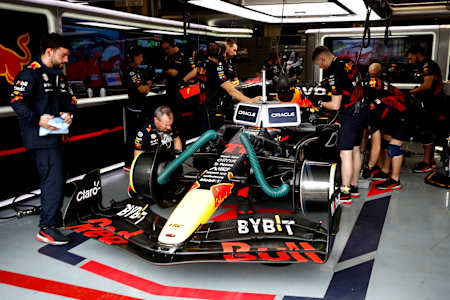
F1
Who are the people working in the shadows of the F1 paddocks as the drivers shine on the track? And what exactly are they doing? Let's find out...
Tune in to any Formula One race and you will inevitably see shots of the paddock as teams celebrate an overtake or look on anxiously as the race unfolds. But just who are the people bustling around and why are there so many of them? Here's a brief overview of the team members who may be relatively unknown but are essential to every F1 race.
01
Team principal
Let's start with the one who leads the group: the team principal. The main objective for this individual is to manage the logistics of the staff and delegate downwards, ensuring that every person within the team has what they need in order to do their work. They're also communicating with the drivers themselves.
Red Bull's Team Principal is Christian Horner, an iconic name in the motorsport who has overseen five World Constructors' titles and six World Drivers' titles since taking the job in 2005. His counterpart Toto Wolff, team boss of championship rivals Mercedes, is another influential figure regularly seen trackside.
Almost as important as the drivers themselves, the team principal is notably responsible for keeping an eye on ensuring the FIA regulations and F1 sporting code are impeccably respected.
02
Engineers
Engineers, as you might well expect, occupy one of the most prestigious positions on the circuit, and their task is also one of the most varied. But what do they do?
First, the performance engineers are responsible for all the elements related to the chassis and its various settings and therefore for predicting its performance.
Then come the control engineers who ensure the gearbox's operation, the assisted braking map and departures and monitor engine overspeeding.
As their name suggests, aerodynamic engineers take care of all the aerodynamic aspects of the single-seater. From the circuits, they transmit data collected to team bosses and the design factory, making sure that everything runs according to the plan.
The engine engineers, meanwhile, are in charge of all the parameters linked to the performance and safety of the F1 power unit. Responsible for the preparation and adjustments of the powertrains, they consider driver feedback on the in-car experience and also manage the zones of deployment for electrical energy.
The strategy engineers are responsible for evaluating the performance of the team, but also that of the adversaries. They also study the various possible scenarios and anticipate the reactions to be had.
03
Technical director
The technical director is responsible for coordinating all of the engineering work above and must ensure that every element of the single-seater works in perfect harmony, from chassis to engine to tires.
04
Chief mechanic
The chief mechanic supervises the (huge) team of mechanics on the circuits. The person must ensure that all the specifications of the car are correct, solving various mechanical problems and making sure all settings of the car are in accordance with the highest standards.
05
Mechanics
A driver without a paddock would be nothing. The mechanics working in the shadows must ensure that the driver has a high-performance, reliable and, above all, safe car. During pit stops, they carry out the usual checks, fill the car with fuel and break the world record for tire change speed. As seen in the video below, they can even do it with zero gravity.
06
Data scientist
The data scientist analyses a whole host of data transmitted by the car in real time (engine performance, aerodynamic efficiency, oil pressure, tire grip, brake wear, etc.) This data ensures that all the technical teams and the driver in the cockpit know exactly what is happening on the track at all times. Another essential role for a Formula One team is to develop in sync with technological advances.
This list is obviously far from exhaustive and only concerns the professions of the people physically present at the circuits. There are many other employees outside the circuits. In total, more than 800 people worked for the Oracle Red Bull Racing team last year.






